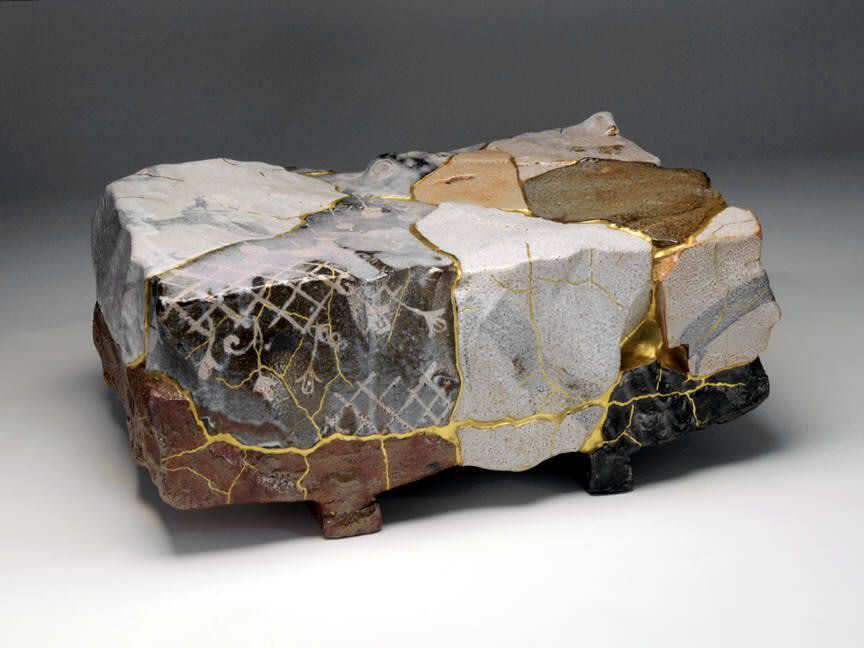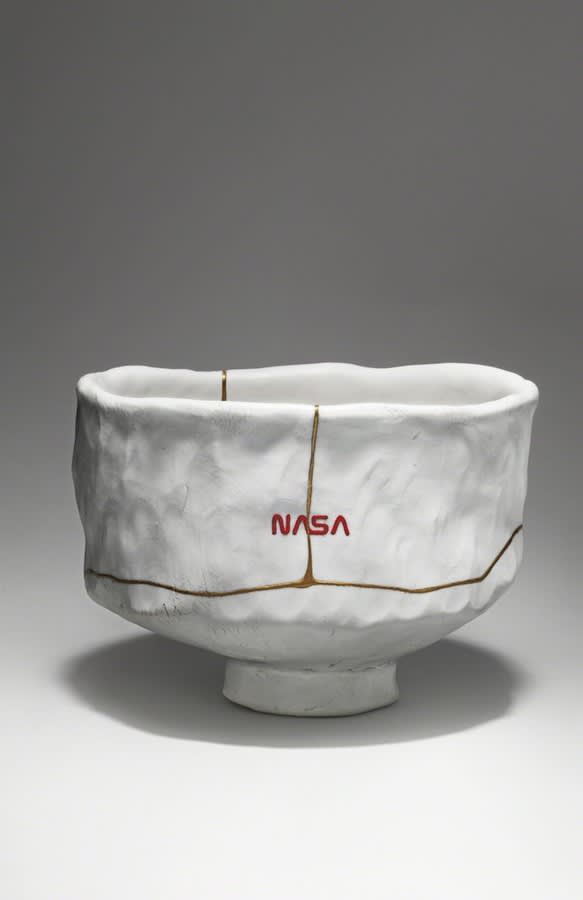
Goro Suzuki
Shino Yobitsugi Daizara, 2010 ceramic
Imperfections and unforeseen outcomes can, at times, produce the most captivating results. While preparing for the unexpected is oftentimes an impossible task, creative solutions in moments of despair can generate lasting results that forever impact the trajectory of culture and tradition.
The Japanese term ‘Kintsugi’, meaning ‘golden joinery’, refers to the art of repairing broken pottery with lacquer that is dusted or mixed with powdered gold. While lacquer ware is a longstanding tradition in Japan, dating back to ancient times, the art of Kintsugi originated in the 15th century when a damaged tea bowl was sent from China restored with ugly metal straps, prompting Japanese craftsmen to devise an aesthetically pleasing alternate means of repair. Collectors were so enamored with the technique, which became closely associated with ceramic vessels used for traditional Japanese tea ceremonies, that individuals were accused of deliberately breaking valuable pottery for the purpose of being repaired with delicate golden seams.
The ideals associated with the art of Kintsugi can be closely linked to the Japanese philosophy of embracing the flawed or imperfect, as well as the ideology of ‘no mind’, which encompasses the concepts of non-attachment and the acceptance of fate as aspects of human life.
In Japanese aesthetics, marks and imperfections produced by wear contribute to the value of an object, encouraging reuse and repair as opposed to disposal. This rationale serves as a primary justification of kintsugi, highlighting cracks and repairs simply as events in the life of an object, rather than considering the piece damaged or broken.
Goro Suzuki
Yobitsugi Stacking Boxes
Goro Suzuki
Gourd-Shaped Sake Flask
Goro Suzuki
Sake Bottle, Green
Goro Suzuki
Yobitugi with Blue Square
Goro Suzuki
Yobitsugi Chawan
Goro Suzuki
Teabowl with Patchwork
While the technique of kinsugi was soon applied to ceramic vessels hailing from other origins throughout the Far East, including China, Korea and Vietnam, contemporary examples honoring this traditional means of repair exist throughout a variety of mediums.
While the technique of kinsugi was soon applied to ceramic vessels hailing from other origins throughout the Far East, including China, Korea and Vietnam, contemporary examples honoring this traditional means of repair exist throughout a variety of mediums.
Artist Tom Sachs, whose work harps on the importance of imperfections caused by the human hand in the process of creation and often exudes influence of Japanese culture, has produced a number of ceramic pieces repaired with kintsugi. In studying with a traditional kintsugi master, Sachs has developed his own, modern method of repair, which utilizes European gold luster as a means of mending porcelain, a refined, durable material that the artist works with to great avail. As branding is an integral theme throughout Sachs’ oeuvre, each work is then labeled with a NASA logo, generating a creative dialogue between the traditional Japanese process and contemporary, Western iconography.

Tom Sachs
Hell raiser, 2018
While the late and great Alexander McQueen referenced Japanese culture on a number of occasions through his couture-level designs, for fall/winter 2011, creative director Sarah Burton enlisted Chinese artist Li Xiaofeng, known for his unique works of wearable art, to create bodices and shoes using shards of porcelain. While the tiled garments and accessories were stitched together and free of gold repair marks, the process was undoubtedly in reference to the traditional repair technique.
Li Xiaofeng
Porcelain Lacoste Polo
Li Xiaofeng
Porcelain Dress
Alexander McQueen
Fall Winter 2011
Alexander McQueen
Fall Winter 2011
Alexander McQueen
Fall Winter 2011
Alexander McQueen
Fall Winter 2011
Perhaps the most direct reference to the art of kintsugi in the context of high fashion was seen on the runway of Dutch designers Viktor & Rolf. For spring 2017, the duo conceived a couture collection comprised of materials and styles from their rich archive, stitching together elements of previously realized designs using delicate golden thread. The collection symbolized fragments of lives and garments previously lived, embracing the reuse of styles that honored kintsugi in both and aesthetic and metaphorical manner.


